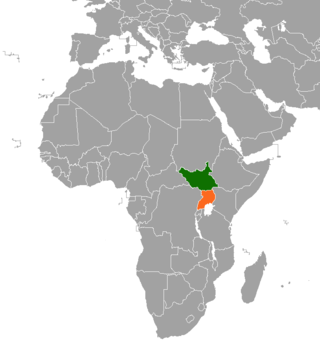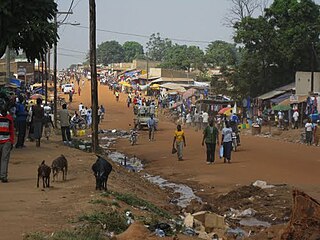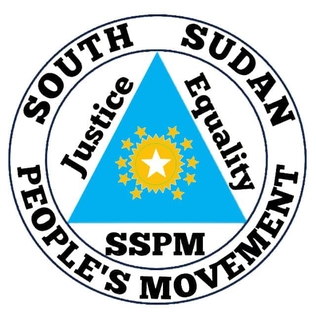
Equatoria is the southernmost region of South Sudan, along the upper reaches of the White Nile and the border between South Sudan and Uganda. Juba, the national capital and the largest city in South Sudan, is located in Equatoria. Originally a province of Anglo-Egyptian Sudan, it also contained most of northern parts of present-day Uganda, including Lake Albert and West Nile. It was an idealistic effort to create a model state in the interior of Africa that never consisted of more than a handful of adventurers and soldiers in isolated outposts.

Central Equatoria is a state in South Sudan. With an area of 43,033 square kilometres (16,615 sq mi), it is the smallest of the original South Sudanese states. Its previous name was Bahr al-Jabal, named after a tributary of the White Nile that flows through the state. It was renamed Central Equatoria in the first Interim Legislative Assembly on 1 April 2005 under the government of Southern Sudan. Central Equatoria seceded from Sudan as part of the Republic of South Sudan on 9 July 2011. The state's capital, Juba, is also the national capital of South Sudan. On October 2, 2015, the state was split into three states: Jubek, Terekeka, and Yei River. The state of Central Equatoria was re-established by a peace agreement signed on 22 February 2020.

The South Sudan People's Defence Forces (SSPDF), formerly the Sudan People's Liberation Army (SPLA), is the military force of the Republic of South Sudan. The SPLA was founded as a guerrilla movement against the government of Sudan in 1983 and was a key participant of the Second Sudanese Civil War, led by John Garang. After Garang's death in 2005, Salva Kiir was named the SPLA's new Commander-in-Chief. As of 2010, the SPLA was divided into divisions of 10,000–14,000 soldiers.

Lainya is a county in Central Equatoria State, South Sudan. Hon Robert John Lasuis the current commissioner of Lainya County after seven commissioner's,

South Sudan and Uganda are neighboring states with strong cultural economic and political ties. The South Sudan and the neighbouring state of Uganda enjoy relatively strong cultural, political, and economic ties. As South Sudan neared independence, both states begun to take advantage of increased opportunities for trade, development and educational exchanges. The rebel group Lord's Resistance Army (LRA), however, continues to operate in the border areas between South Sudan, the Democratic Republic of Congo and Uganda.
Ethnic violence in South Sudan has a long history among South Sudan's varied ethnic groups. South Sudan has 64 tribes with the largest being the Dinka, who constitute about 35% of the population and predominate in government. The second largest are the Nuers. Conflict is often aggravated among nomadic groups over the issue of cattle and grazing land and is part of the wider Sudanese nomadic conflicts.

The South Sudanese Civil War was a multi-sided civil war in South Sudan between forces of the government and opposition forces. In December 2013, President Salva Kiir accused his former deputy Riek Machar and 10 others of attempting a coup d'état. Machar denied trying to start a coup and fled to lead the Sudan People's Liberation Movement-in-Opposition (SPLM-IO). Fighting broke out between the Sudan People's Liberation Movement (SPLM) and SPLM-IO, igniting the civil war. Ugandan troops were deployed to fight alongside the South Sudanese government. The United Nations has peacekeepers in the country as part of the United Nations Mission in South Sudan (UNMISS).

Amadi State was a state in South Sudan that existed between 2 October 2015 and 22 February 2020. Amadi state formed from Western Equatoria state on 2 October 2015, following a decree that established the state along with 27 other states. It was located in the Equatoria region. Amadi State bordered Eastern Lakes State, Jubek State, Maridi State, Terekeka State, Western Lakes State, Yei River State.

Yei River State was a state in South Sudan that existed from 2 October 2015 to 22 February 2020, when it became a part of the state of Central Equatoria.

Yei River County is an administrative area in Central Equatoria with a large population of people who settled in that particular county.
Operation Thunderbolt was the codename for a military offensive by the South Sudanese SPLA rebel group and its allies during the Second Sudanese Civil War. The operation aimed at conquering several towns in Western and Central Equatoria, most importantly Yei, which served as strongholds for the Sudanese Armed Forces (SAF) and helped the Sudanese government to supply its allies, the Ugandan insurgents of the WNBF and UNRF (II) based in Zaire. These pro-Sudanese forces were defeated and driven from Zaire by the SPLA and its allies, namely Uganda and the AFDL, in the course of the First Congo War, thus allowing the SPLA to launch Operation Thunderbolt from the Zairian side of the border. Covertly supported by expeditionary forces from Uganda, Ethiopia, and Eritrea, the SPLA's offensive was a major success, with several SAF garrison towns falling to the South Sudanese rebels in a matter of days. Yei was encircled and put under siege on 11 March 1997. At the same time, a large group of WNBF fighters as well as SAF, FAZ, and ex-Rwandan Armed Forces soldiers was trying to escape from Zaire to Yei. The column was ambushed and destroyed by the SPLA, allowing it to capture Yei shortly afterward. Following this victory, the South Sudanese rebels continued their offensive until late April, capturing several other towns in Equatoria and preparing further anti-government campaigns.

The South Sudan Opposition Alliance is a coalition of political parties and armed groups in South Sudan that opposed the government of President Salva Kiir. It was formed in February 2018 in Addis Ababa, Ethiopia, by nine groups. In September the alliance acceded to a revised peace deal with the government that also included the main rebel faction, the Sudan People's Liberation Movement-in-Opposition, but some of the member groups disagreed with the decision and split from the alliance. The pro-deal SSOA has experienced continued tension between its members, as well as with the government.
This article lists events from the year 2019 in South Sudan
The Battle of Bor was one of the first battles of the South Sudanese Civil War, consisting of a series of clashes for the city of Bor, the capital of Jonglei State, between the SPLA and SPLA defectors under Peter Gadet, part of the force that would become the SPLA-IO. The city changed hands four times between December 18, 2013 and January 18, 2014, ultimately leaving the SPLA in control.
Lieutenant general Thomas Cirillo Swaka is a South Sudanese politician and the leader and Commander in Chief of the National Salvation Front (NSF), a rebel group opposing the government of the Republic of South Sudan.

Moro Isaac Jenesio is one of the Youthful Leaders of South Sudan. Moro is currently the Minister of Local Government and Law Enforcement for Central Equatoria State in the Transitional Government of National Unity, as of 2023. He is also the Chairperson of the South Sudan National Movement for Change (SSNMC), a constituent Member of South Sudan Opposition Alliance (SSOA) which is one of the leading Partners to RARCSS 2018 South Sudan.
Lt. General Peter Cerillo Swaka was a South Sudanese Politician and a former commander of the Anyanya movement and governor of Equatoria region in the 1980s.

Between February 2022 and April 2023, clashes broke out in the Abyei area of South Sudan between Twic Dinka militias against Ngok Dinka militias, regarding control of the border between Abyei and South Sudan's Twic County. The conflict ended temporarily following a ceasefire between the Twic Dinka and Ngok Dinka in May 2023. In September 2023, attacks flared up in the border area between Abyei and Twic County between Twic Dinka and Ngok Dinka youth, with several massacres against Ngok Dinka.

South Sudan People's Movement/Army (SSPM/A) is a South Sudan opposition movement founded on 1 May 2021. In 2023, the group operated along the South Sudan-Sudan border in Upper Nile and Unity State.
Stephen Buay Rolnyang is a South Sudanese rebel leader of SSPM/A and former SSPDF general. He founded the SPLA elite force in 2006. Rolnyang belongs to Nuer.












